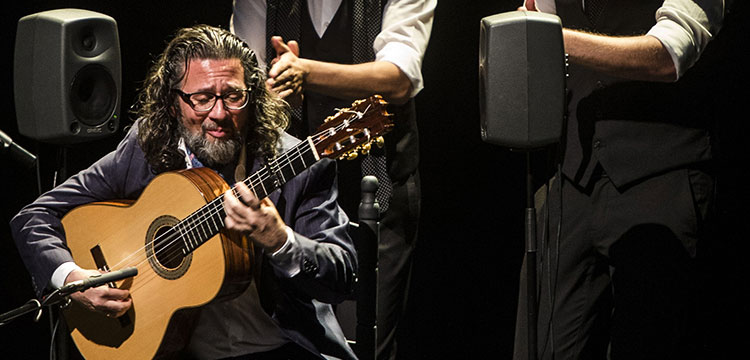“Sonanta de tocaor” – José Gálvez guitar. Luis el Zambo, voice. Miguel Lavi, voice. Manuel Cantarote and Juan Diego Valencia, palmas. Guest artist: Joaquín Grilo, dance.
José Manuel Gómez Gufi
The show began with a poem and a firm resounding voice from the shadows telling us that guitar in Jerez is taken seriously, developed between two neighborhoods with well-defined styles, and José Gálvez appears with his instrument, with the heavy-duty rhythm of Manuel Cantarote and Juan Diego Valencia, and they launch into bulerías which is where most people finish. But hey, the sound is deafening!
I turn to the sound technician, but he must be behind glass in the flashy red room of the Teatros del Canal, so shouting the classic: “the sound is over-modulating!” does not guarantee that the message will reach its destination, I look around and the whole audience seem to be delighted to be there, and they applaud the bulerías and its over-amplification as if it were Sonic Youth, the Pixies or Lagartija Nick (rock groups that deliberately saturate their guitars as an artistic technique). That doesn’t appear to be the case, Gálvez was born on Cantarería street in the Santiago neighborhood, and anyone can see Diego del Morao on Youtube. Modern, but up to a point.
The next two pieces remind me of the documentary “El Cante Bueno Duele”, a portrait of Jerez and the much-missed Moraito Chico. Miguel Lavi comes on, and the saturation remains, I can’t actually say I like him in siguiriyas, at this point I have a nagging headache, and I go out of the theater to report on the sound problem.
They tell me it’s not one of their technicians, and inform someone about the complaint.
JOAQUIN GRILO RETURNS TO MADRID
Joaquín Grilo appears, someone I’ve followed since he recorded some bulerías for Thelonius Monk (the extraordinary jazz pianist and composer), on Chano Domínguez’ first solo recording. A few months ago he appeared with Diego Carrasco, and you always feel like seeing him dance because he talks with his feet and doesn’t need guitar or rhythm, because it’s all right there, in the shoes, and he has the figure of a dancer, for a moment he deconstructs the hips and plays at being a child, or an old woman, and gestures to the guys keeping rhythm to gather round…and the beat turns invisible.
Tremendous and synthetic
It was all worthwhile, and I realize the sound equipment is pointing straight at my seat, which explains the excessive volume. I must be seated in the spot for deaf people. I change seats as Luis Zambo comes on, having recently performed at the García Lorca room without mike or electricity, and the singer’s first gesture is of scissors to cut the soleá, in other words the monitor where the guitar sounds.
There was an encore in which the main performer, José Gálvez, sang a song of his own. Summing up, Luis Zambo again triumphed in Madrid, although he was surely more enjoyable at the unplugged Lorca venue. There was still the fiesta finale in which everyone forgot about the mikes – “Long live la Paquera!” – and they did a fine job with the singing and the bulerías.
Photography, David Mudarra
